
In July, Joe, Piero, Andy, and I had the pleasure of leading the annual Cafe Imports Barista Origin Trip, a prize given to each of the U.S. regional barista champions, the U.S. national champion, and the world champion. These champions might be laid back (or not) and act like hipsters (or not), but behind whatever image they’ve chosen as their own are fierce, dedicated professionals who has sacrificed significant portions of their professional and personal time on the altar of coffee. When we plan the Barista Origin Trips, our goal is to give them the keys to the kingdom in whatever coffee country we’re going to. We want them to feel like kid’s at Disneyland, to see things that surprise and awe them, and to leave with a renewed passion for coffee and this industry that we love.
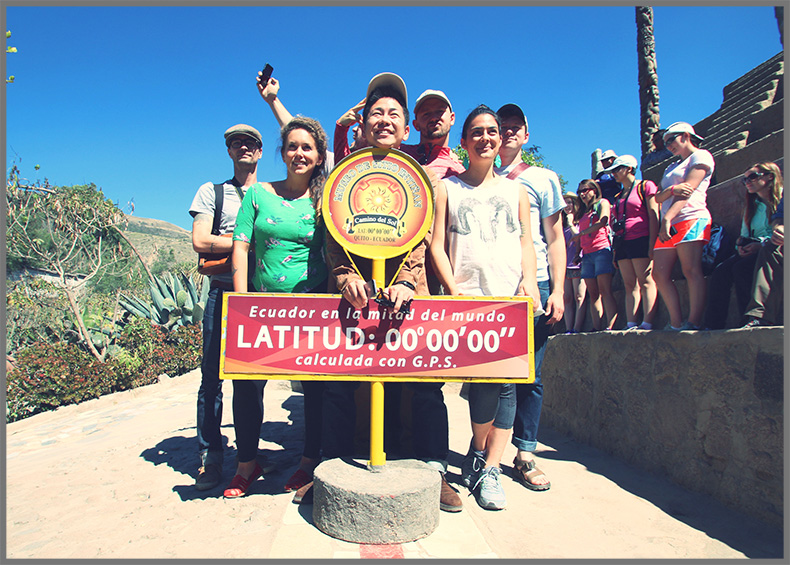
As it turns out, Ecuador pretty much blows you away all on its own so our jobs in this case were to hang on and capture as much of it as possible in the time we had.
Our adventure started in Quito in northern Ecuador. Quito is the capital city and, at more than 9,000 feet above sea level, is the highest capital city in the world. Quito is surrounded by ‘cloud forests,’ which meant that we woke up on our first morning in Ecuador to this view:
After a quick breakfast at our hotel, some friendly commiserating about altitude sickness, and justifiably dubious forays into the hotel’s coffee, we loaded into the small bus that would be our second home for the next four days and hit the road to go visit some farms. It took several hours to reach our first destination, during which I happily absorbed the interesting mix of impassioned, professional discussion on brewing methods and competition rules, life stories, and ‘that’s what she said’-esque jokes that were flowing thickly between the baristas and our crew.
Our first visit of the day was to producer Fabian Lomas’ farm. The Cafe Imports crew was especially excited to explore this particular farm. This May we cupped a new variety that they’ve been growing, named Sidra, that blew us all away. It broke the 95 point barrier and had us waxing poetically about tropical fruits, wild floral sweetness, and freshly pressed cider. Joe actually roasted some and brought it with us on the trip so after a morning of exploring the farm, we all retreated to brew up some of the coffee that had come from those very trees. Most of the baristas were trying Sidra for the first time and it was exciting to watch them experience the same awe and joy of discovery that we had.
On a personal note, this was my first trip to origin and standing in the sunshine biting into a coffee cherry that I’d just picked off the tree is an experience that will stay with me a long time. I wasn’t alone in that experience and I could not have handpicked a more eclectic and dedicated band of coffee travelers to experience that with.
After we explored the farm itself, we toured the beds where the coffee is dried and the machines used to process it. Because the volume of coffee is relatively small from this particular farm, the machinery involved in processing was much smaller in scale and more labor-intensive in operation. This was my first glimpse into the amazing ingenuity that producers use to achieve their processing objectives. A variety of tools and machines had been repurposed and combined. The ingenuity and attention to detail reminded me of visiting a craft artisan in the U.S. and seeing lovingly refurbished original machinery.
After saying our grateful farewells to our hosts, we climbed back into the bus and headed for another nearby farm, Finca Maputo. Finca Maputo is owned by a doctor and his wife. It was fascinating to hear his perspective on the spread and treatment of rust. At one point when we were marveling at the quick, robust recovery of his trees from what would normally have been a devastating brush with rust, he simply said ‘I’m a doctor. I know how to apply medicine.’
Finca Maputo is a relatively large farm and its processing facilities reflected that in both scale and automation. It also had a large nursery where they’re experimenting with different ways to grow trees that are healthy enough to withstand rust.
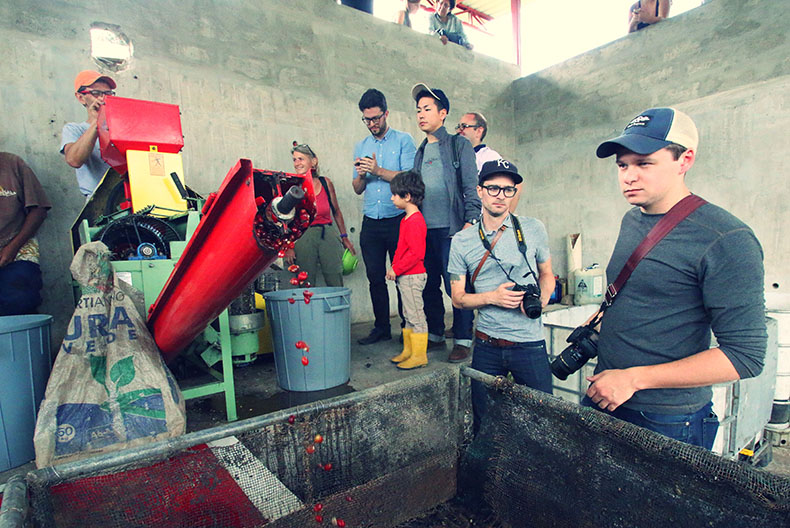
After a lovely lunch with our hosts at their home, we headed to a private ecological reserve where we spent the evening relaxing and getting to know one another more.
The next day we headed to a dry mill owned and run by Ena Galletti and her husband Don. Ena is a larger than life personality and the number of coffee-related activities she has her hand in is truly astounding. She and her family do everything from growing to milling to roasting, not just for themselves but for a wide range of farmers in the sprawling northern region.
Ena walked us through the mechanics of her dry mill and coffee roastery and also treated us to a blind cupping. The Sidra once again peeked through as the favorite among the group, but there were definitely some other promising coffees on the tables. We also got a chance to meet some local baristas, who stopped by to say hi but had to hurry off because they were preparing for a barista jam that we’d be attending later that evening.
We spend the afternoon taking a tour of Quito, which is full of interesting colonial history. That evening, after a very full day already, we pulled up outside of a gorgeous white converted church where the barista jam would be held. Because the local producers and baristas had arranged this event, we weren’t sure exactly what to expect. It didn’t really matter because even if someone had told us how epic the event would be, we wouldn’t have believed them. Baristas from around the city were there. Producers were there. And tons of the city’s coffee fans were there. By the time things got rolling, it was literally standing room only.
The jam was held in a relatively large chapel and the juxtaposition of religious iconography, espresso machines and siphons, disco lights, and pumping local music should have been strange but somehow worked. The baristas answered questions from the crowd, gave demonstrations on how to pour latte art, and had a latte art throwdown. And took lots and lots of pictures with grinning fans.
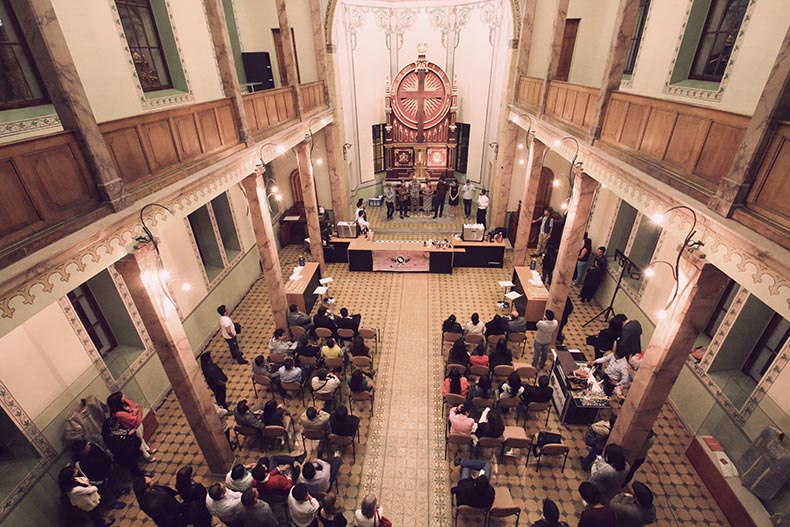
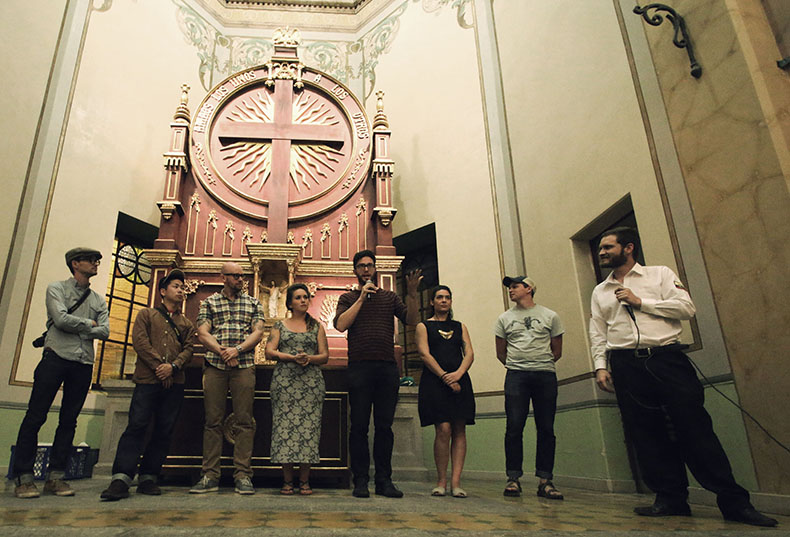
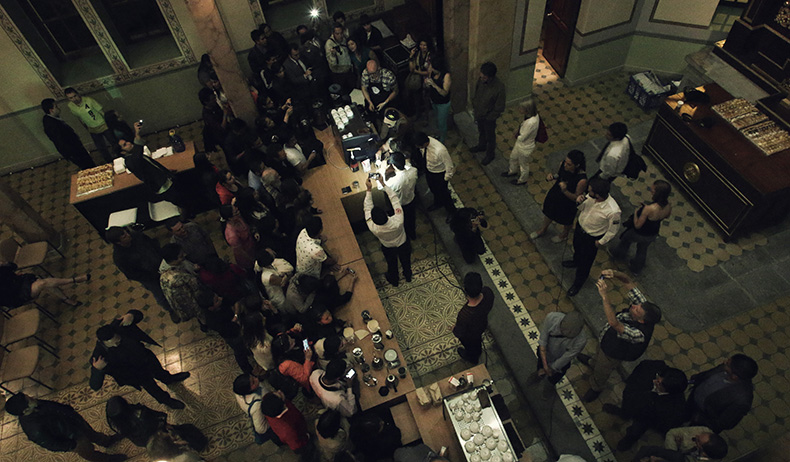
After another night in Quito, we all piled into the bus for a 5 hour drive (aka extreme group bonding time) out to Hacienda Primavera, a ‘wilderness ecolodge’ owned by Ena’s family. Hacienda Primavera is easily one of the most beautiful places I’ve ever seen and after a couple days of intense traveling, it was a sweet relief to arrive somewhere that virtually demanded that you relax.
The baristas spent the afternoon horseback riding (many for the very first time) and then we headed out to see the wet mill Ena’s organization runs. They were having some water issues because a line had been cut so while the producers waited for the water tank to fill up, Ena took us on a short hike down to a nearby river. At which point pretty much everyone stripped down to various undergarments and jumped in.

By the time they’d gotten the water situation straightened out and fired up the wet mill, it was dark out. We spent a long time watching the producers dump bags of perfectly ripe cherries into the tank, reaching down and tasting the different varieties and comparing notes with one another, listening as Ena and Joe took turns explaining the exact mechanics of the machine we were watching, holding out our hands to catch the mucilage-free beans as they came out of the chute, and examining the green coffee for size and insect damage. More importantly, we were all sorting through what we were seeing and experiencing and tying it back to our own roles in the coffee supply chain.
Ena is a larger than life personality and it should have come as no surprise that the evening was not over after our wet mill experience. We went back to Hacienda Primavera and ended up dancing late into the night to an Afro-music band that had driven out from who-knows-where to come play for just our small band of merry travelers. I didn’t take an official headcount, but the band may have had more members in it than were in our party.
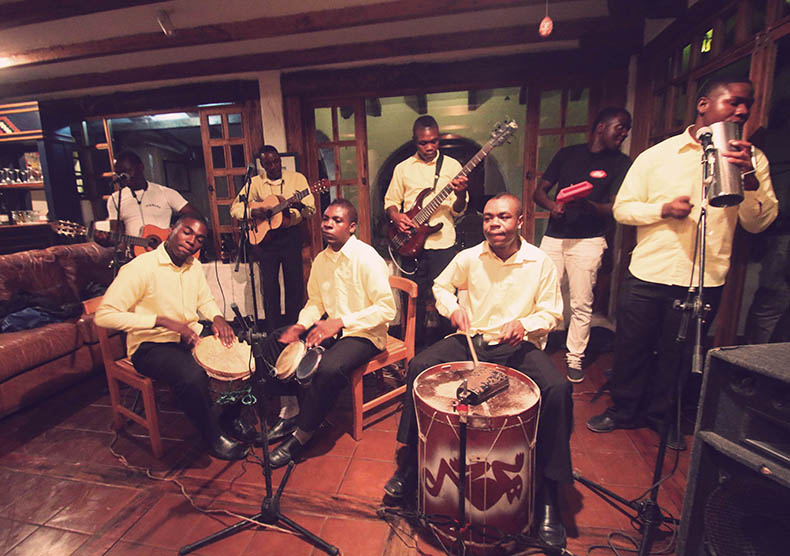
The next day after a quick stop at the equator to test all of the equator ‘myths’ Joe had been telling us about (which all turned out to be true), we were off to Guayaquil in the south, where we’d spend the final two days of our whirlwind tour of Ecuador.
Our first day in Guayaquil started with a trip to a large, low elevation robusta farm. The differences between the small, mountainous arabica farms we’d seen in the north and the sprawling, flat, orderly robusta farm were striking. With it’s underground drip irrigation systems, droves of seasonal workers, and neat uniform rows of short, easy-to-pick trees, the robusta farm could have been any small scale agricultural operation in the States.
After showing us the robusta side of his operation, which is a relatively new endeavor, the manager of Hacienda Victoria showed us his real passion–and something we’d been looking forward to all week–his cacao farm. The parallels between cacao and coffee were surprising. Both grow in pods on a tree, have to be removed from their outer fruit, and are set out to dry. The texture and flavor of cacao straight out of the pod, still covered in its spongy white fruit is almost impossible to describe, like a combination of honey, tropical fruit, and rich cream. It reminded me of good oysters, fleshy and sweet.
After thoroughly interrogating their resident processing expert about the different drying systems they’re experimenting with and whether any of the techniques they’re trying would translate to coffee, we retired to an airy pavillion on a hill overlooking the farm for a chocolate tasting and lunch.
After lunch we got to hang out on the farm. Hide found a zip line that went out to an island in a small lake and the baristas took turns trying to make it across without ending up in the lake. There was a full scale ring for bull-fighting, complete with fake practice bull (essentially horns attached to a large trike), which we also made good use of.
On our final day in Guayaquil, we had a free day. All you really need to know about that day can be summed up in this picture:

As we slowly parted ways on our various flights, two things struck me. First, that we were extremely lucky to have shared this experience with such a fantastic group of people. The hugs as we all parted were real. Second, that our objective–of breathing new life into each of our passion’s for coffee–had been more than achieved, thanks to the naturally intoxicating beauty of Ecuador and the warm dedication of its coffee community.
-Kate Moss
for a full photo album from the trip, Click Here